10 Pro-Worthy Flower Arrangement Ideas From the Experts
These floral displays are stunning yet simple.
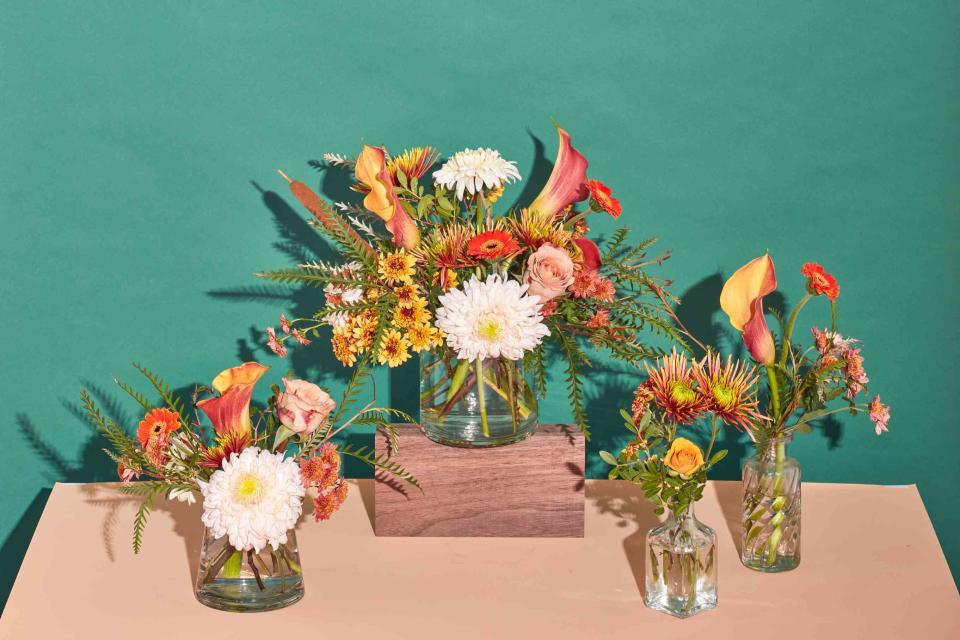
Photo by Jarren Vink, Florals by Marcella Rodriguez Broe of The Parcel Flower Co.
The advent of spring brings so many wonderful perks, from perfect 70-degree days to fresh ramps and singing songbirds. Another surefire sign of the season? A bounty of blooms! Whether you’re a green thumb gardener who tends to your own buds or a frequent visitor to your local florist, styling fresh spring and summer flowers into your home is a great way to nod to the season.
Still, flower arranging can be intimidating, and achieving a pro-worthy display is easier said than done. It’s not just about picking pretty flowers; it’s about creating a cohesive palette, focusing on an eye-catching shape, and choosing a complementary vessel. Sound tough? It can be—but lucky for you, we’ve got the pros on our side. Below, we’re rounding up 10 expert tips from real florists, all geared toward helping you make the most of your seasonal blooms. From nailing a monochromatic palette to putting a twist on the traditional vase, these flower arrangement ideas will give your florals the staring moment they deserve.
Related: How to Make Flowers Last Longer, According to Florists
Extend Enjoyment with Ikebana
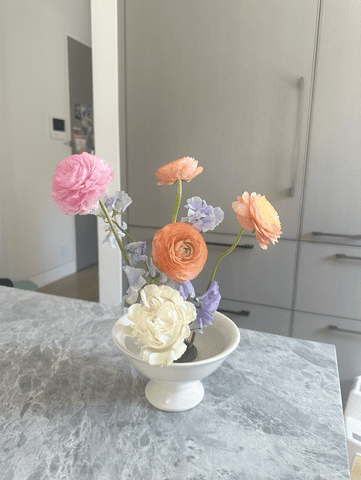
Photo and Florals by Lori-Lee Lindenburg of Lori-Lee Floral
There’s no denying that flowers are beautiful, but they’re also fleeting. If you find your original arrangement is wilting—or your first year gardening didn’t generate as many blooms as you’d like—an ikebana-style arrangement is a great way to go intentionally minimalistic. “When a floral arrangement appears to be wilting, rather than discarding the entire arrangement, you can salvage the freshest stems and recreate a new, beautiful arrangement,” says florist Lori-Lee Lindenburg of Lori-Lee Floral. “I like to use a floral frog to rework my arrangements into an Ikebana-style structure. I position each bloom at different heights and angles to design a new, simple floral arrangement.”
Fluff Up Your Flowers
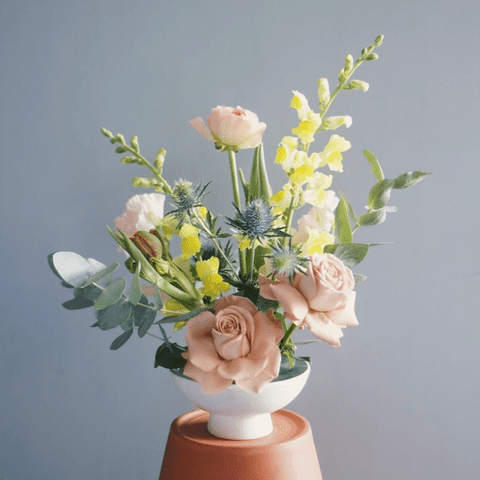
Photo and Florals by Kelli Galloway of Hops Petunia
You may think a rose can’t get any more beautiful—but you’d be wrong. To give everyone’s favorite stunner even more prominence, gently fold back the petals to make your blooms appear bigger and fluffier. “To create a beautiful focal point in this arrangement, we used a gorgeous rose and reflexed the petals to give it a more romantic look,” says florist Kelli Galloway of Hops Petunia. “Reflexing petals is a technique in which you delicately fold back the first two to three layers of petals—it works great on roses and tulips!”
Create a Cohesive Collection
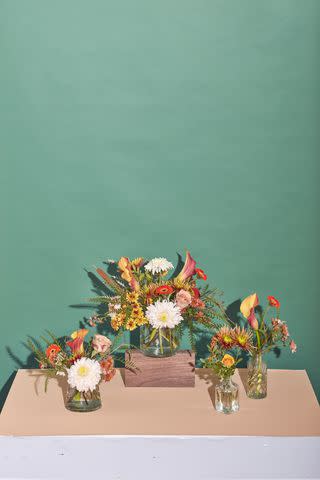
Photo by Jarren Vink, Florals by Marcella Rodriguez Broe of The Parcel Flower Co.
Some occasions—like a dinner party or celebratory BBQ—call for more than one floral arrangement, but keeping your vision cohesive across each display can be tough. The key? Start big, then work your way down. "When designing multiple arrangements, I first craft a larger focal arrangement that sets the tone for the color palette and design style,” says florist Marcella Rodriguez Broe of The Parcel Flower Co. “The smaller arrangements then complement and extend the theme, creating a cohesive and visually appealing story that flows throughout the space or down the length of your table.”
Play With Asymmetry
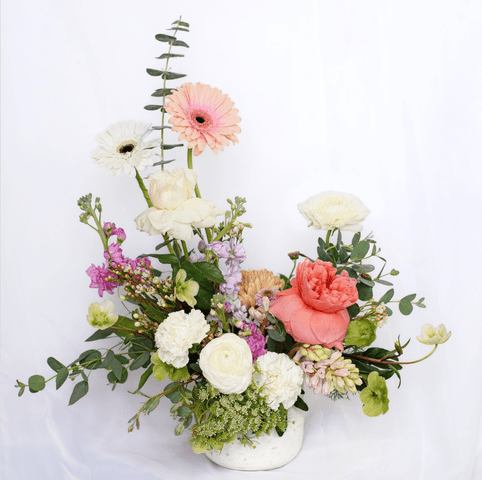
Photo and Florals by Shauna Grobowsky of Passionate Blooms Floral Design
If you really want to create a pro-worthy flower arrangement, styling your blooms into a graphic shape is a great way to ensure each stem gets its moment in the spotlight. “To create a dreamy asymmetrical flower design, arrange them in a vase, allowing some stems on one side to be taller than the opposite side,” says florist Shauna Grobowsky of Passionate Blooms Floral Design. “Step back periodically to assess and adjust until you achieve the dreamy, ethereal effect you desire.”
Choose a Unique Vessel
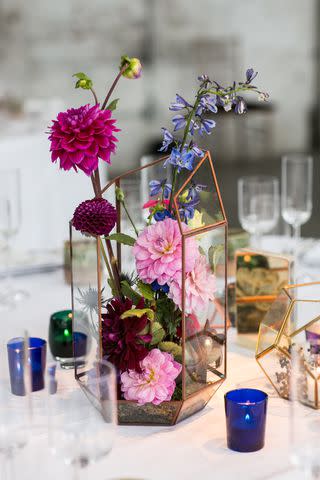
Photo by Prema Photographic Photography Florals by Mimosa Floral
Experimenting with flower arranging is all about having fun and flexing your creativity. And one of the best ways to showcase your personality when flower arranging is with your vase pick. Instead of turning to a traditional ceramic vessel, mix it up with a basket, bowl, or terrarium. “For this arrangement, we used a low bowl with a floral frog that we then covered with moss and placed inside the terrarium,” says florist Lilli Wright of Mimosa Floral. “Flower frogs are great because they enable you to use less traditional vessels. We love arranging in all sorts of pieces, especially at home. Anything can be a vase if it holds water—experiment and have fun!”
Keep Your Palette Tight
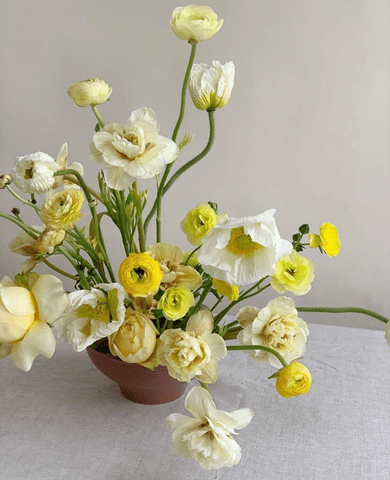
Photo and Florals by Sarah Wahhab of Mulberry & Moss
Flowers come in literally every color of the rainbow, which means your options for creating a color palette are just as endless. For a chic and understated (not to mention professional) look, stick to a tight, monochromatic array of minimalistic hues. “In this arrangement, soft buttery yellow tulips serve as a bridge tone between white poppies and bright yellow ranunculus,” says florist Sarah Wahhab of Mulberry & Moss. “This helps to create a soothing blend of tones within a monochromatic color palette for a calm yet captivating look.”
Take It to the Tropics
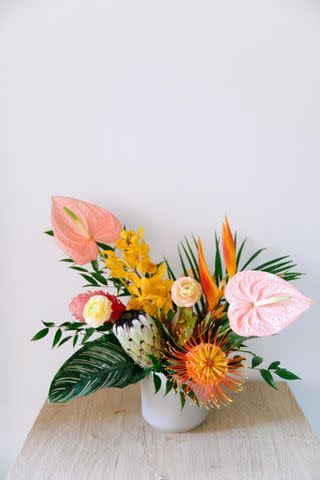
Photo by The Pine Collective, Florals by Luluâs Lei and Bouquets
Novelty can be fun, especially when it’s a prickly, funky, or quirky bloom you’ve never seen before. To add immediate visual interest to your at-home flower arrangement, try adding a few tropical blooms to your display. “Tropical blooms that are typically the most easily accessible are anthuriums, orchids, and birds of paradise,” says florist Laura Cho-Stutler Lulu’s Lei and Bouquets. “We usually place them on the edges of our designs because of their unique shapes, while more circular flowers are placed in the middle. Also, we encourage a blend of garden variety flowers like ranunculus, garden roses, and lisianthus with tropicals to help soften the overall aesthetic.”
Add a Moody Touch
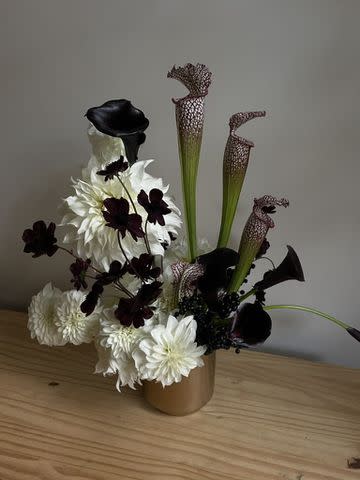
Photo and Florals by Jennifer Huynh of Future Flowers
When most people picture florals, they think of romantic pink and white blooms—so you may be surprised to realize that they also come in equally moody hues like chocolate brown and deep black-burgundy. If you want to really wow, combine a palette of soft shades with a bold, inky hue. “Designing high-contrast arrangements is one of my favorite ways to add drama and sensuality to a tablescape,” says florist Jennifer Huynh of Future Flowers. “For this design, I created a base of cream dahlias, then punctuated the arrangement with an explosion of burgundy and chocolate calla lilies, cosmos, and sarracenia. The color palette lends well to the sculptural design."
Focus on a Hero Bloom
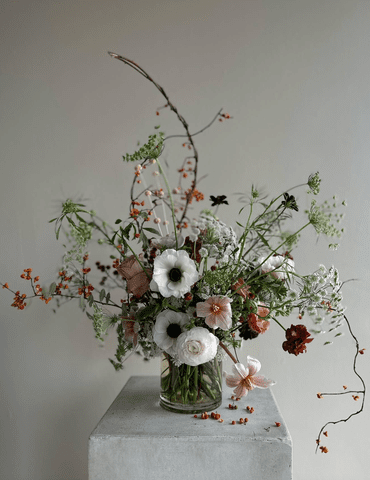
Photo and Florals by Rikki Marcone of Rikki Marcone Floral & Event Design
You’ll often hear florists refer to a “hero” bloom in an arrangement, and while it sounds technical, it’s actually a sneaky strategy that can save you a bit of money. Essentially, it means using only a few of your standout flowers toward the center of your display, fleshing out the rest of the arrangement with more subtle blooms. “Heavy texture was important for this arrangement,” says florist Rikki Marcone of Rikki Marcone Floral & Event Design. “I used Queen Anne's lace and bittersweet to create a fluffy, cloud-like base, then added a few focal flowers, like anemones, in my negative space, placing two of them strategically close to bring the viewer's eye directly to that focal area.”
Make It Mini
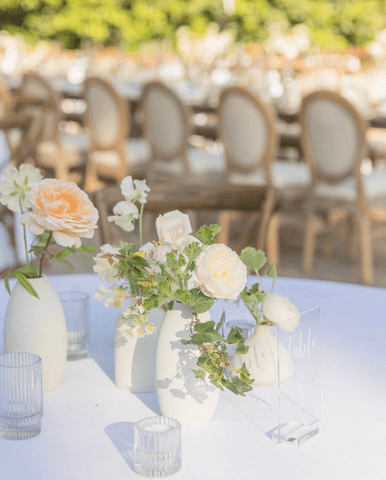
Photo by Emily Baucom Photography, Florals by Rose Bay Floral Co.
Intimidated by the thought of creating an oversized arrangement? No sweat; itty bitty can be just as beautiful. The trick to arranging a dynamic display of bud vases lies in embracing simplicity—and odd numbers. “To bring an organic touch to your table, opt for an odd number of bud vases, filled with stems at various heights,” says florist Alarie Schimpff of Rose Bay Floral Co. “For this look, we relied on a neutral palette but kept dimension by using a handful of garden roses with cream, blush, and apricot undertones. Incorporating greenery clippings from your yard is always a nice touch—we love using ivy or vines, which add movement and interest to designs.”
For more Real Simple news, make sure to sign up for our newsletter!
Read the original article on Real Simple.


